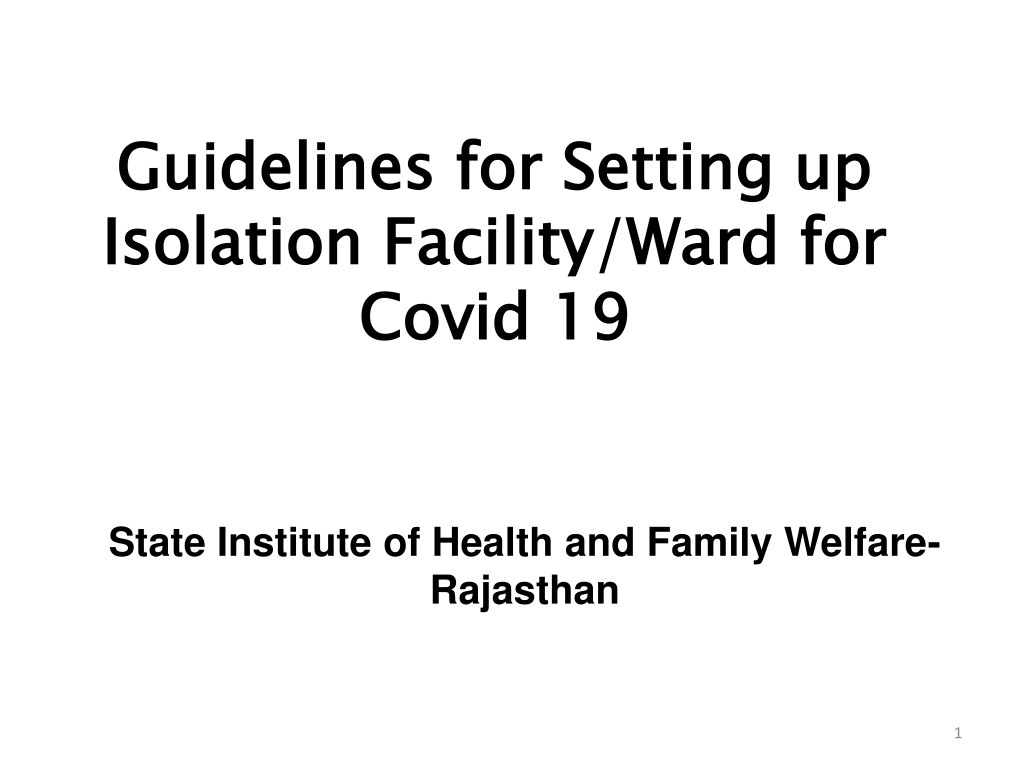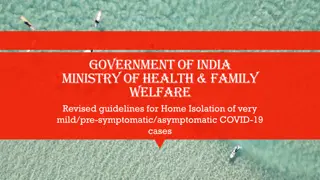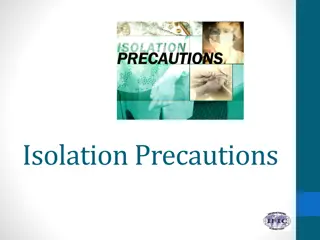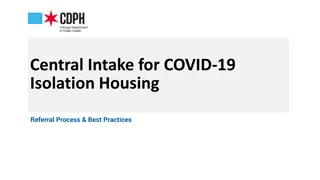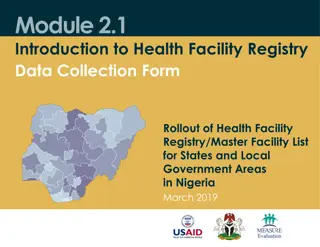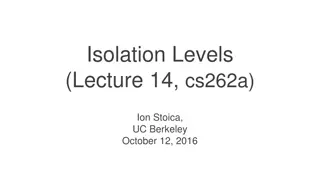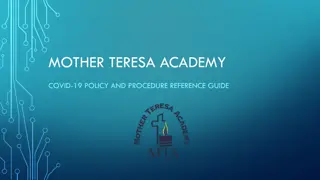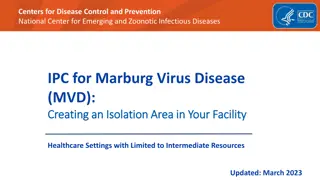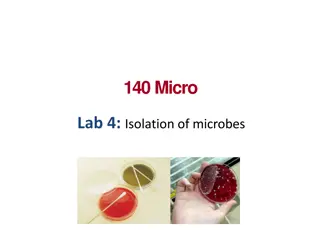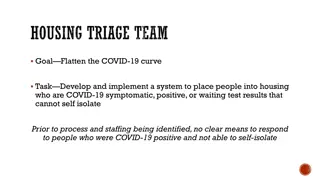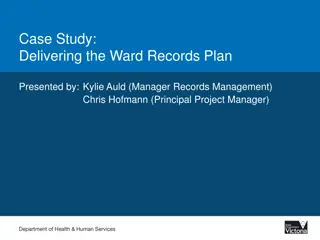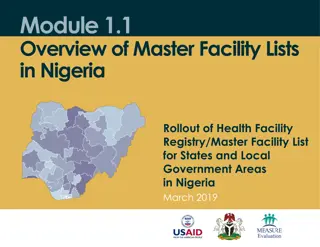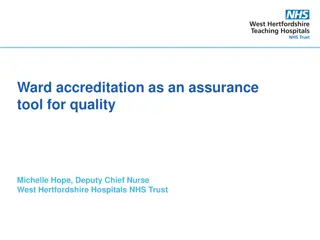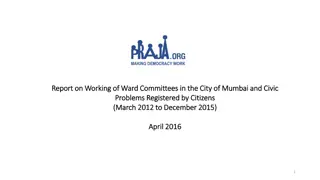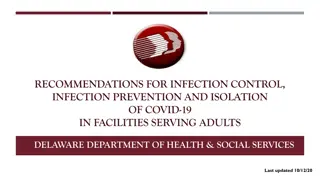Guidelines for Setting up Isolation Facility/Ward for Covid-19 Management
Quarantine and isolation measures are crucial for breaking the chain of transmission in the community. Isolation involves separating individuals who are ill or suspected of having COVID-19, while quarantine is for those exposed and potentially at risk. Specific protocols and facilities are necessary for effective Covid care, such as designated triage areas, physical barriers, and isolation ward setup guidelines at state and district levels. It is essential to have dedicated isolation wards with proper amenities and separate entry/exit points to ensure efficient care and prevent further spread of the virus.
Download Presentation

Please find below an Image/Link to download the presentation.
The content on the website is provided AS IS for your information and personal use only. It may not be sold, licensed, or shared on other websites without obtaining consent from the author. Download presentation by click this link. If you encounter any issues during the download, it is possible that the publisher has removed the file from their server.
E N D
Presentation Transcript
Guidelines for Setting up Isolation Facility/Ward for Covid Guidelines for Setting up Isolation Facility/Ward for Covid 19 19 State Institute of Health and Family Welfare- Rajasthan 1
Quarantine and isolation Quarantine and isolation Quarantine and Isolation are important mainstay of cluster containment. These measures help by breaking the chain of transmission in the community. Quarantine refers to separation of individuals who are not yet ill but have been exposed to COVID-19 and therefore have a potential to become ill. There will be voluntary home quarantine of contacts of suspect /confirmed cases. 2
Isolation Isolation Isolation refers to separation of individuals who are ill and suspected or confirmed of COVID-19. All suspect cases detected in the containment/buffer zones (till a diagnosis is made), will be hospitalized and kept in isolation in a designated facility till such time they are tested negative. Persons testing positive for COVID-19 will remain to be hospitalized till such time two of their samples are tested negative as per MoHFW s discharge policy. About 15% of the patients are likely to develop pneumonia, 5% of whom requires ventilator management 3
Covid Covid Care Care Health Facility Should have Designated ARI/COVID-19 triage area Availability of signage directing to triage area and signage to instruct patients to alert staff if they have symptoms of COVID-19 Physical barriers (e.g., glass or plastic screens) at reception areas available to limit close contact between triage staff and potentially infectious patients Triage protocols Specific waiting area for people with respiratory symptoms Non-contact Infra-Red registration desk and at Triage Area near the thermometer 4
Isolation Ward State level - a minimum of 50 beds. District level -a minimum of 10 beds. To create a 10 bed facility, a minimum space of 2000 sq. feet area clearly segregated from other patient care areas is required. Post signages on the door indicating that the space is an isolation area. 5
Isolation Ward Preferably the isolation ward should have a separate entry/exit and should not be co- located with post-surgical wards/dialysis unit/SNCU/labour room etc. It should be in a segregated area which is not frequented by outsiders. The access to isolation ward should be through dedicated lift/guarded stairs. The isolation ward should have a separate toilet with proper cleaning and supplies. 6
Isolation Ward Isolation Ward There should be double door entry with changing room and nursing station. Enough PPE should be available in the changing room with waste disposal bins to collect used PPEs. Used PPEs should be disposed as per the BMWM guidelines. Set up a telephone or other method of communication in the isolation room or area to enable patients, family members or visitors to communicate with health-care workers. This may reduce the number of times the workers need to don PPE to enter the room or area. 7
Isolation ward/room layout Post signage on the door. Ensure appropriate hand-washing facilities. Ensure appropriate room ventilation (>12 ACH). Ensure directional control of air flow, with air flow entering the room only when the door is open, and exhausted outside safely. In naturally ventilated airborne precaution rooms, the air flow should be directed to areas free of transit, or safely outside where it may be diluted. Isolation ward/room layout 8
Room setup Remove all non-essential furniture; the rest should be easy to clean, and should not conceal or retain dirt or moisture within or around it. Set up a trolley outside the door to hold PPE. Stock PPE supply and linen outside the precaution room/ area (e.g. in the changing room). Stock the sink area with suitable supplies for hand washing, and with ABHR near the point-of-care and room door. Place appropriate waste bags in a bin. If possible, use a touch- free bin. Dirty bins should remain inside the precaution rooms. Place a puncture-proof container for sharps disposal inside the precaution room/area. Place an appropriate container with a lid outside the door for equipment that requires disinfection or sterilization. 9
Isolation Ward Spacing between beds In Isolation Ward, should be 1 2 metres. Single rooms Single rooms reduce the risk of transmission of infection from the source patient to others by reducing direct or indirect contact transmission. Single rooms should have: hand-washing facilities toilet and bathroom facilities. Anterooms Single rooms used for isolation purposes may include an anteroom to support the use of PPE 10
Placement and admissions A room should be cleaned before admitting a patient. There should be a policy for cleaning the room (i) after patient discharge (terminal cleaning) and (ii) before admission. All patient-care items used by the previous patient should be removed and replaced with clean items, e.g. bed linen, waterproof covering, oxygen humidifiers, face mask, etc. Patient-care equipment and articles should be cleaned, disinfected or sterilized according to the disinfection policy 11
Transport of patients Transport of patients Movement and transportation of patients from the isolation room or area should be restricted to essential purposes only. This will reduce the possibility of transmission of microorganisms in other areas of the HCF. Appropriate precautions should be taken during transportation to reduce the risk of transmission of microorganisms to other patients, HCWs or the hospital environment equipment) or (surfaces 12
Ventilation/ Negative pressure Ventilation/ Negative pressure Ensure adequate room ventilation. If room is air- conditioned, ensure 12 air changes/ hour and filtering of exhaust air. A negative pressure in isolation rooms is desirable for patients requiring aerosolization procedures (intubation, suction nebulisation). These rooms may have standalone air- conditioning. These areas should not be a part of the central air-conditioning. If air-conditioning is not available negative pressure could also be created through putting up 3-4 exhaust fans driving air out of the room. 13
Ventilation/ Negative pressure Ventilation/ Negative pressure In district hospital, where there is sufficient space, natural ventilation may be followed. Such isolation facility should have large windows on opposite walls of the room allowing a natural unidirectional flow and air changes. The principle of natural ventilation is to allow and enhance the flow of outdoor air by natural forces such as wind. 14
Inside Isolation Ward Inside Isolation Ward Place appropriate waste bags in a bin. If possible, use a touch-free bin. Ensure that used (i.e. dirty) bins remain inside the isolation rooms. Place a puncture-proof container for sharps disposal inside the isolation room/area and bio- medical waste should be managed as per the BMWM guidelines. 15
Inside Isolation Ward Inside Isolation Ward Keep the patient s personal belongings to a minimum. Keep water pitchers and cups, tissue wipes, and all items necessary for attending to personal hygiene within the patient s reach. 16
Inside Isolation Ward Inside Isolation Ward Non-critical stethoscope, thermometer, blood pressure cuff, and sphygmomanometer) should be dedicated for the patient, if possible. Any patient-care equipment that is required for use by other patients should be thoroughly cleaned and disinfected before use. Avoid sharing of equipment, but if unavoidable, ensure that reusable equipment is appropriately disinfected between patients. patient-care equipment (e.g. 17
Inside Isolation Ward Inside Isolation Ward Place an appropriate container with a lid outside the door for equipment that requires disinfection or sterilization. Ensure that appropriate hand washing facilities and hand-hygiene supplies are available. Stock the sink area with suitable supplies for hand washing, and with alcohol-based hand rub, near the point of care and the room door. 18
Cleaning/Disinfection Cleaning/Disinfection Ensure regular cleaning and proper disinfection of common areas, and adequate hand hygiene by patients, visitors and care givers. Keep adequate equipment required for cleaning or disinfection inside the isolation room or area, and ensure scrupulous daily cleaning of the isolation room or area. 19
Infection Prevention And Control Practices Isolation area should have Functioning hand washing stations (including water, soap and paper towel or air dry) Uninterrupted running water supply Alcohol based hand sanitizer Posters to reinforce hand washing and PPE at hand washing stations Staff should follow Five movements of hand washing Six steps of hand washing Infection Prevention And Control Practices 20
Environmental Cleaning Staff should be trained in housekeeping and infection control practices Linen should be stripped from the bed with care taken not to shake the linen during this action Linen should be soaked in disinfectant, i.e. hypochlorite 1:50 for 20 minutes for white clothes and coloured linen as per hospital policy suitable high-level disinfectant to be used and then sent to the laundry. All other articles such as IV stands and furniture should be cleaned with detergent and disinfected followed by high-level disinfectant. Walls should be cleaned with detergent and mopped with a high-level disinfectant. The bathrooms should be cleaned with detergent and water followed by disinfection with hypochlorite 1:50 dilution. Environmental Cleaning 21
At discharge At discharge The pillows and mattress covers are to be cleaned with detergent, disinfected with a high level disinfectant and sent to the laundry. Bed sheets, curtains, gowns and dusters must be removed, soaked in with a high-level disinfectant for one hour and then sent to laundry. After disinfection, wash the room, wall, window, doors, bathroom, sink and furniture with soap solution after doing thorough high dusting in that cubicle. 22
At discharge At discharge Soak bed pan, urinal, kidney basin in with a high-level disinfectant for one hour, wash with detergent and dry it under sunlight. Wash basin, multi-bin, bucket, jugs, mugs are washed with soap solution and dried in sunlight. Rubber sheets (Mackintosh) are to be cleaned with detergent and water, dried, powdered and replaced. 23
Visitors Visitors Visitors to the isolation facility should be restricted /disallowed. For unavoidable entries, they should use PPE according to the hospital guidance, and should be instructed on its proper use and in hand hygiene practices prior to entry into the isolation room/area. Ensure that visitors consult the health-care worker in charge (who is also responsible for keeping a visitor record) before being allowed into the isolation areas. 24
Staff Doctors, nurses and paramedics posted to isolation facility need to be dedicated and not allowed to work in other patient-care areas. Keep a roster of all staff working in the isolation areas, for possible outbreak investigation and contact tracing. All health staff involved in patient care should be well trained in the use of PPE. Consider having designated portable X-ray and portable ultrasound equipment. 25
Training Training Education and job-specific training to HCP regarding Signs and symptoms of infection Triage procedures including patient placement and filling the CIF safely collect clinical specimen Correct infection control practices and PPE use HCP sick leave policies Recommended actions for not using recommended PPE how and to whom suspected cases (covid- 19)should be reported 26
Checklist for isolation rooms Eye protection (visor or goggles) Face shield (provides eye, nose and mouth protection) Reusable vinyl or rubber gloves for environmental cleaning Latex single-use gloves for clinical care Hair covers Particulate respirators (N95, FFP2, or equivalent) medical (surgical or procedure) masks Gowns and aprons Single-use long-sleeved fluid-resistant or reusable non-fluid- resistant gowns Plastic aprons (for use over non-fluid-resistant gowns if splashing is anticipated and if fluid-resistant gowns are not available) Alcohol-based hand rub Plain soap (liquid if possible, for washing hands in clean water) Clean single-use towels (e.g. Paper towels) Sharps containers Checklist for isolation rooms 27
Checklist for isolation rooms Checklist for isolation rooms Appropriate detergent for environmental cleaning and disinfectant for disinfection of surfaces, instruments or equipment Large plastic bags Appropriate clinical waste bags Linen bags Collection container for used equipment Standard IEC Standard protocols for hand hygiene, sample collection and BMW displayed clearly Standard Clinical management protocols 28
Wearing and removing Personal Protective Equipment Before entering the isolation room or area: Collect all equipment needed; Perform hand hygiene with an alcohol-based hand rub (preferably when hands are not visibly soiled) or soap and water; Put on PPE in the order that ensures adequate placement of PPE items and prevent self-contamination and self- inoculation while using and taking off PPE; an example of the order in which to don PPE when all PPE items are needed is hand hygiene, gown, mask or respirator, eye protection and gloves Wearing and removing Personal Protective Equipment 29
Leaving the isolation room or area Leaving the isolation room or area Either remove PPE in the anteroom or, if there is no anteroom, make sure that the PPE will not contaminate either the environment outside the isolation room or area, or other people. 30
Remove PPE Remove PPE in a manner that prevents self-contamination or self- inoculation with contaminated PPE or hands. General principles are: Remove the most contaminated PPE items first; Perform hand hygiene immediately after removing gloves; Remove the mask or particulate respirator last (by grasping the ties and discarding in a rubbish bin); Discard disposable items in a closed rubbish bin; Put reusable items in a dry (e.g. Without any disinfectant solution) closed container; an example of the order in which to take off PPE when all PPE items are needed is gloves (if the gown is disposable, gloves can be peeled off together with gown upon removal), hand hygiene, gown, eye protection, mask or respirator, and hand hygiene Perform hand hygiene with an alcohol-based hand rub (preferably) or soap and water whenever un-gloved hands touch contaminated PPE items. 31
Source of above information Source of above information https://ncdc.gov.in/WriteReadData/l892s/424176 46181584529159.pdf https://www.mohfw.gov.in/pdf/National%20Guide lines%20for%20IPC%20in%20HCF%20- %20final%281%29.pdf 32
Thank You 33
